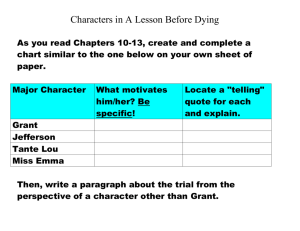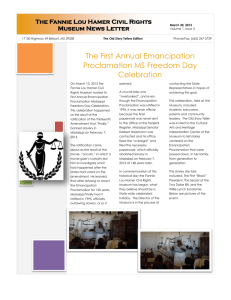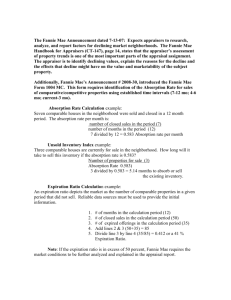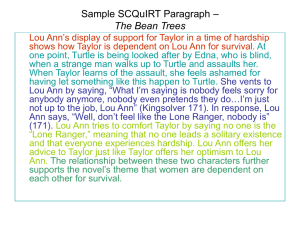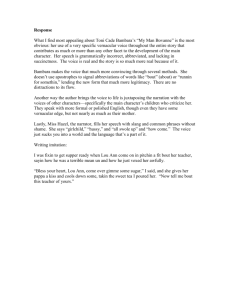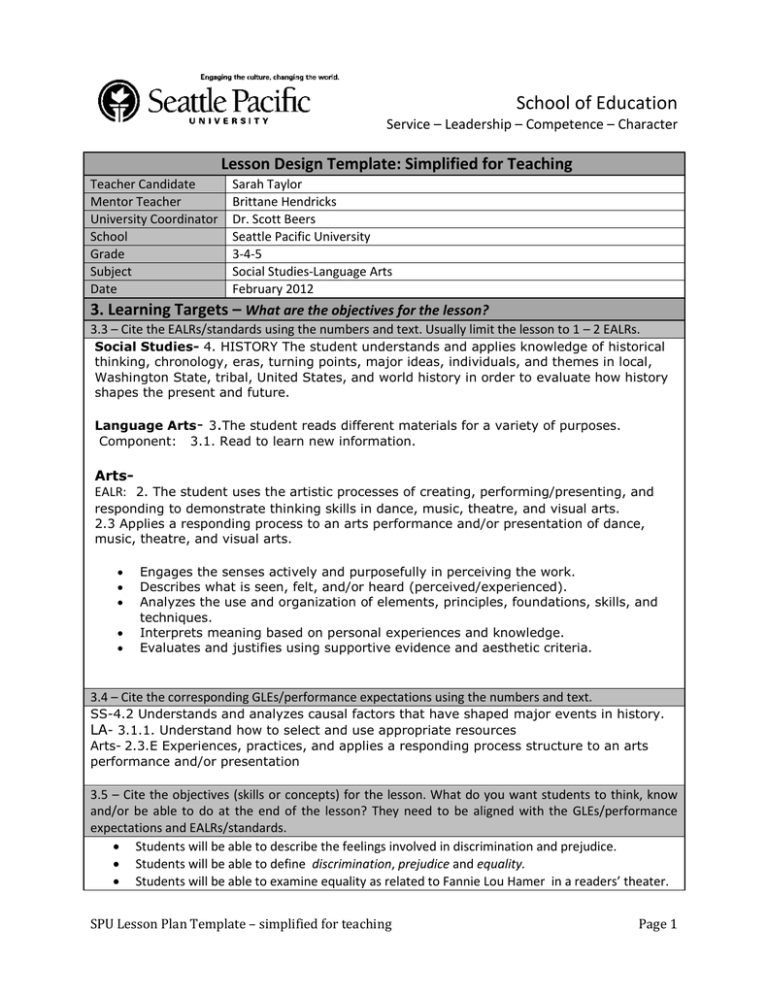
School of Education
Service – Leadership – Competence – Character
Lesson Design Template: Simplified for Teaching
Teacher Candidate
Mentor Teacher
University Coordinator
School
Grade
Subject
Date
Sarah Taylor
Brittane Hendricks
Dr. Scott Beers
Seattle Pacific University
3-4-5
Social Studies-Language Arts
February 2012
3. Learning Targets – What are the objectives for the lesson?
3.3 – Cite the EALRs/standards using the numbers and text. Usually limit the lesson to 1 – 2 EALRs.
Social Studies- 4. HISTORY The student understands and applies knowledge of historical
thinking, chronology, eras, turning points, major ideas, individuals, and themes in local,
Washington State, tribal, United States, and world history in order to evaluate how history
shapes the present and future.
Language Arts- 3.The student reads different materials for a variety of purposes.
Component: 3.1. Read to learn new information.
ArtsEALR: 2. The student uses the artistic processes of creating, performing/presenting, and
responding to demonstrate thinking skills in dance, music, theatre, and visual arts.
2.3 Applies a responding process to an arts performance and/or presentation of dance,
music, theatre, and visual arts.
Engages the senses actively and purposefully in perceiving the work.
Describes what is seen, felt, and/or heard (perceived/experienced).
Analyzes the use and organization of elements, principles, foundations, skills, and
techniques.
Interprets meaning based on personal experiences and knowledge.
Evaluates and justifies using supportive evidence and aesthetic criteria.
3.4 – Cite the corresponding GLEs/performance expectations using the numbers and text.
SS-4.2 Understands and analyzes causal factors that have shaped major events in history.
LA- 3.1.1. Understand how to select and use appropriate resources
Arts- 2.3.E Experiences, practices, and applies a responding process structure to an arts
performance and/or presentation
3.5 – Cite the objectives (skills or concepts) for the lesson. What do you want students to think, know
and/or be able to do at the end of the lesson? They need to be aligned with the GLEs/performance
expectations and EALRs/standards.
Students will be able to describe the feelings involved in discrimination and prejudice.
Students will be able to define discrimination, prejudice and equality.
Students will be able to examine equality as related to Fannie Lou Hamer in a readers’ theater.
SPU Lesson Plan Template – simplified for teaching
Page 1
Students will be able to cooperatively participate in play.
Students will be able to examine evidence in Readers’ Theater to support theme of equality and
civic responsibility.
4. Lesson Assessment – How will students demonstrate their learning?
4.8 – Complete the following table to highlight what the students will do to demonstrate competence
specific to learning for this lesson.
Description of
What the assessment is
formative assessment
Evaluative criteria
Feedback to students
designed to assess
activity
Questioning to activate Use of both strategic
Understanding prior
Verbal feedback and
specific
vocabulary
and
knowledge,
connections
modeling
prior lesson knowledge
academic
language.
and
predictions
and
of making connections
skills -prediction and
language skills specific
and predicting
personal connections
to equality and
prejudice
Questioning and
modeling personal
Question as we read
through the story A
Picture Book of Martin
Luther King, Jr. by,
David A Adler
Use of both strategy
specific vocabulary and
academic language.
skills –questioning:
before, during and after
Questions specific to
before, during and after
story structure and
play.
Use of precise academic
language specific to
story and play.
Application of prior
knowledge and
development of
questioning strategy
skills specific to specific
to equality and
prejudice
Verbal feedback and
modeling
Application and proper
use of vocabulary:
prejudice and unequal
Verbal feedback and
modeling and use for
building observations of
use of proper
vocabulary terms.
Concept attainment and
lesson progression.
√- for completion
0- incomplete (see
teacher)
Description of
summative assessment
activity
Worksheet specific to
the play about Fannie
Lou Hamer.
Name three places in
the play where you
What the assessment is
designed to assess
Evaluative criteria
Complete sentences
using academic
language specific to the
details with in the play
in relationship to who,
what when, where,
why, how.
Feedback to students
Level of understanding
Rubric for worksheet
of skill specific
about Fannie Lou
questioning to support
Hamer play
reading comprehension.
+ Completed
assignment with full
sentences. Questions
SPU Lesson Plan Template – simplified for teaching
Page 2
read about prejudice.
What happened to
Fannie Lou when she
started to sing on the
bus?
Why do you think
voting was so important
to Fannie Lou?
What did they call the
mock election? Why do
you think they choose
that name?
included details from
text and used
appropriate academic
language.
Demonstrated pride in
penmanship by writing
clearly and concisely.
√ Completed
assignment with
sentences. Included
some detail from text
and used minimal
academic language
skills. Handwriting was
fine.
O- Needs some
improvement see
teacher (note will be
attached for further
instruction)
5. Instructing and Engaging Students in Learning – What will happen in the lesson?
5.5 – Describe the sequence of steps in the lesson in the following table. General lesson sequences may
be more directive (e.g., ITIP) or open (constructivist). Whatever design is used, the lesson needs to be
explicitly outlined.
Complete the following table:
Provide an estimate of time.
List the sequence of the various learning experiences in the lesson.
Time
Learning experiences
5 min
Before the lesson starts:
As students enter the class I pass out a special snack (pretzels or goldfish) to
only half the class (boys) as the student begins to on morning seat work.
When the children question this I say “only the boys are getting snacks today”
25 min
Lesson Starts:
After about 5 minutes I will call student to the front of the class and begin
reading the book, A Picture Book of Martin Luther King, Jr. by, David A
Adler
After I am done reading I ask the students who did not receive the snacks
(girls) how they felt about that?
They I ask the students who did receive the snack how they felt about that?
SPU Lesson Plan Template – simplified for teaching
Page 3
10 min
60 min
20 min
20 min
Then I ask students if they thought that was fair? What is fair? Was it equal
treatment for all? I explain I was demonstrating prejudice or unequal treatment
I ask does anyone know what prejudice means? I will define: Preconceived
opinion not based on reason or experience.
I then give snack to the students who did not get it and ask them to return to
their tables.
What prejudice means to them?
Why people have prejudice?
How prejudice may lead to discrimination and inequality?
Why do you think some people might be prejudice? (fear, ignorance,
echoing parents sentiments)
What do you think people can do to overcome their prejudice? (learn about
others,(cultures-beliefs-desires-dreams) discuss fears, cooperate with others,
show tolerance etc.)
Today we are going to be doing a readers theater about an African-American
woman named Fannie Lou Hamer. This is a true story about her fight for the
right to vote. In 1962 African-American people were not allowed to vote.
Does this sound fair? Why/why not?
I will assign parts in the play by drawing characters out of a hat.
As I have 26 students and there are 13 parts we will be doing the play twice.
Each student will participate in a performance and then participate as an
audience member for deeper understanding of the theme.
As I pass out scripts I will as students to “Listen for details”
Instances where they hear prejudice and unequal treatment of people
Events that happened to lead to Fannie Lou taking a stand against
prejudice
What happened to Fannie Lou when she sang on the bus?
Why was voting so important to Fannie Lou? Who else has this had an
effect on?
What did they call the “mock” election?
Also listen for acts of bravery that Fannie Lou demonstrates. We will be
sharing these things in a discussion after the performances.
After the Readers Theater Discussion:
What examples of prejudice did you see/ hear in this play?
How did Fannie Lou work to change the unequal treatment of African-Americans?
What are some ways to combat, overcome and eradicate these issues within a
community?
What might you have done if you were in the same situation?
How has Fannie Lou’s fight for equality and they stories/fights of many others
affected the world we live in today? (Obama?)
SPU Lesson Plan Template – simplified for teaching
Page 4
Worksheet in class: (see Attached)
Journaling/ Homework:
Tonight I want you to write about your feelings in relationship to unequal treatment
or prejudice. I would like you to pick 5 questions that you will respond to using
complete sentences and nice penmanship.
Here are some ideas you could write about:
1. How did you feel when you received/did not receive snack at the beginning
of class?
2. How did you feel when you listened to the storybook about MLK Jr.?
3. How did you feel when you were reading the play?
4. How did you feel when you were listening to the play?
5. Did you have different feelings when you were simply watching the play
versus participating?
6. What does freedom mean to you?
7. What are some reasons that people have prejudice?
8. Write about a time when you have felt or witnessed unequal treatment of
prejudice. How could you help someone to overcome a prejudice?
A Long Road to Freedom (a play): Fannie
Lou Hamer
Source: Action
ABOUT THE PLAY
For years, African-Americans were denied equal rights all across this country. In 1962, one
woman decided to take a stand. She wanted to vote but was told she couldn't. She wouldn't
take no for an answer. Her name was Fannie Lou Hamer. This is her true story.
CHARACTERS
Fannie Lou Hamer
Pap Hamer, her husband
Will, a civil rights worker
James, a civil rights worker
Mr. Dee, plantation owner
SPU Lesson Plan Template – simplified for teaching
Page 5
Officer
Farmer
Registrar
Sheriff
Mrs. Cobb, Fannie's neighbor
Mr. Taylor, Fannie's neighbor
Narrator 1
Narrator 2
SCENE 1
Narrator 1: It's 1962 in Ruleville, a small town in Mississippi. Fannie Lou Hamer lives in a
shack on "Mr. Dee's" plantation with her husband, Pap, and their two daughters.
Narrator 2: Early one morning in August, there's a knock. Pap finds two young white men
standing at the door.
Will: Good morning, Mr. Hamer. We're having a meeting tonight at the church to talk to
black folks about registering to vote. Can you attend?
Pap: We don't vote around here.
James: Don't you want a better life for your children?
Pap: I know you boys mean well, but you better be going.
Narrator 1: Fannie Lou and Pap watch the young men knock on their neighbors' doors.
Pap: Anybody that goes to that meeting is asking for big trouble.
Fannie Lou: I don't know, Pap. We've been waiting so long for things to change. Maybe it's
time we did something.
Pap: Maybe it's not. Black folks are murdered for speaking up, and people don't question it
when it happens.
Fannie Lou: That's even more reason to stop waiting and start changing things ourselves.
Like that man said, don't we want a better life for our children?
SCENE 2
SPU Lesson Plan Template – simplified for teaching
Page 6
Narrator 2: Fannie Lou is one of the better cotton pickers on Mr. Dee's plantation. This day,
she is called in to clean Mr. Dee's house.
Narrator 1: Mr. Dee sits in the kitchen looking at a catalog.
Fannie Lou: Morning, Mr. Dee. What's that you're eyeing?
Mr. Dee: Machines. They pick cotton as quickly as 20 people put together. I'm getting one.
Narrator 2: Fannie Lou gets a worried look on her face.
Fannie Lou (to herself): Picking cotton is hard work, but it's the only decent job a black
person can get here. Now even that might be taken away by machines.
Narrator 1: Mr. Dee points to some cleaning supplies.
Mr. Dee: Don't forget to dust under the couches.
Fannie Lou: I thought I'd start in the bathroom.
Mr. Dee: Don't worry about that. It's only the dog's bathroom.
Narrator 2: Fannie Lou starts to get angry. As she cleans, she keeps hearing Mr. Dee's
words, "It's only the dog's bathroom."
Narrator 1: Her family doesn't have running water or a toilet inside their shack, but Mr.
Dee's dog has its own bathroom!
SCENE 3
Narrator 2: That night, Fannie Lou goes to the voter-registration meeting. The police patrol
outside with dogs. The mayor writes down names as people walk in.
Narrator 1: There are 30 people at the meeting. Two people stand up and say they are
from the Student Nonviolent Coordinating Committee (SNCC). The organization works to
help black people win civil rights.
James: I know you risked a lot coming here tonight. And I know you saw the mayor writing
down names. But he is an elected official. People voted him into office. People can vote him
out.
SPU Lesson Plan Template – simplified for teaching
Page 7
Will: In order to do that, though, you have to go down to the county office to register. That's
the first step on the long road to freedom.
Mrs. Cobb: We'll lose our jobs if we try that! Or worse!
James: If you're fired, we'll make sure your family eats.
Will: We have a bus going down to the county courthouse on Friday. Who will come with
us?
Narrator 2: Fannie Lou looks around. Not one hand is up. People are afraid. She's scared
too. Slowly she raises her hand.
Fannie Lou: I'll go.
Narrator 1: Fannie Lou's neighbors are inspired. They raise their hands, too.
SCENE 4
Narrator 2: One Friday, Fannie Lou and 15 others ride a school bus to the courthouse.
When they arrive, the sheriff blocks the door. His hand is on a gun.
Sheriff: What are you here for?
Will: We came to register to vote.
Sheriff: You can't bring all these people inside. You'll have to go in two at a time.
Narrator 1: Fannie Lou and her neighbors wait for hours. Finally it's Fannie Lou's turn. She
steps up to the desk.
Registrar: What's your name?
Fannie Lou: Mrs. Hamer.
Registrar: Who's your boss?
Fannie Lou: Mr. Dee.
SPU Lesson Plan Template – simplified for teaching
Page 8
Registrar: I want you to interpret the 16th section of the Mississippi state constitution,
regarding "de facto" laws.
Fannie Lou: I-I don't know what "de facto" laws are.
Narrator 2: The registrar laughs and slams the voting book shut.
SCENE 5
Narrator 1: Fannie Lou and her neighbors ride back to Ruleville in silence.
Fannie Lou: The test was hard. I guess I didn't pass. Maybe I'm too dumb to vote after all.
Will (angry): They only make the test hard for blacks. Whites get a much easier test. Some
can't read and they still pass!
Narrator 2: Suddenly, a police officer stops the bus. Will and James get out.
Narrator 1: Inside the bus, people are nervous.
Narrator 2: Fannie Lou starts singing. She gets everyone to join in. When James and Will
return, everyone in the bus is calm.
James: They fined us $30. Our bus is too yellow, they said.
Fannie Lou: Too yellow? What does that mean?
Will: It means they're trying to scare us. They don't want you to vote. They want us to back
down.
SCENE 6
Narrator 1: The next morning, Mr. Dee comes over to Fannie Lou's shack.
Mr. Dee: Where were you yesterday? I couldn't find you.
Fannie Lou: Trying to register to vote.
Mr. Dee: We can't have that! Get your name off that list, and everything will be like it was
before.
SPU Lesson Plan Template – simplified for teaching
Page 9
Fannie Lou: I don't want things to be the same as before.
Mr. Dee: I'm warning you only once: Get your name off that list! Or leave this plantation
today!
Fannie Lou: Then, I guess I'll have to leave.
Mr. Dee (shouting): You have two hours to get out!
Narrator 2: Pap watches Fannie Lou pack the few things she has.
Pap: Fannie Lou, it's not too late. You could reconsider. This is our home. We've been here
for 18 years.
Fannie Lou (angry): For 18 years, I've taken care of Mr. Dee's children and kept his books.
I've nursed his family when they were sick. How come I'm good enough to do all that but not
good enough to vote?
Pap: Why is voting so important?
Fannie Lou: If all these people are trying to keep us from doing it, it must be pretty
important.
SCENE 7
Narrator 1: Fannie Lou moves off the plantation. Will and James hire her to help them
register people to vote.
Narrator 2: Soon after, violence breaks out in Ruleville. Houses are set on fire. Two girls
are shot and seriously injured.
Pap: This voting drive is getting dangerous, Fannie Lou. We've gotta make sure you're safe
until things calm down.
Fannie Lou: I didn't want to drag you and the girls into this, Pap. I'll take care of myself.
You make sure the kids are okay.
Narrator 1: Fannie Lou goes to SNCC training classes and meetings across the South.
Wherever she goes, she tells people how important it is to register to vote.
SPU Lesson Plan Template – simplified for teaching
Page 10
Narrator 2: When she comes back to Ruleville, it's winter. People there are hungry. There
isn't much work.
Narrator 1: Fannie Lou helps give out clothes and food in town. Hundreds of people line up.
She gets an idea.
Fannie Lou: Don't push! There's plenty for everybody. But you have to register to vote first.
Mrs. Cobb: Mrs. Hamer, you got a jacket for my boy?
Fannie Lou: I sure do, but you've got to come down to the county courthouse on Friday.
Mrs. Cobb: Okay. It's a deal.
Mr. Taylor: Forget voting. We've got to eat, Mrs. Hamer!
Fannie Lou: You've got to vote, too, or you'll never be a first-class American.
Mr. Taylor: But look how much you lost for trying to register!
Fannie Lou: Black people have been beaten and killed for no reason. Now at least we are
suffering for something positive.
SCENE 8
Narrator 2: Slowly, more and more blacks register to vote. But the test they give blacks to
register is still very hard. Fannie Lou has failed the test a few times. This time, she is ready.
James: Good Luck, Fannie Lou.
Fannie Lou: I studied hard and I know every word of the constitution. They won't be able to
turn me down this time.
James: Don't count on that, Fannie Lou. The odds are against you. If you were white, you
might not even have to take a test.
Fannie Lou: That's why I'm going to keep trying. It's not fair. Nothing's going to stop me.
Narrator 1: Finally, in January 1963, Fannie Lou passes the test. She has registered to
vote.
SPU Lesson Plan Template – simplified for teaching
Page 11
SCENE 9
Narrator 2: In June, Fannie Lou and two of her fellow workers are arrested outside a
restaurant in Mississippi.
Narrator 1: The police give no reason for bringing them to jail. They question Fannie Lou.
Officer: Where are you from?
Fannie Lou: Ruleville.
Officer: I just checked the FBI's records on you. You were in South Carolina a few months
ago. Why?
Fannie Lou: I was there for citizenship-training school.
Officer: You were there to march. And you were there to see Martin Luther King Jr. We are
not going to have that. Understand?
Narrator 2: An hour later, the officer leads Fannie Lou into another cell. He orders two
black inmates to beat Fannie Lou.
Officer: I want you to make her wish she was dead.
Narrator 1: The inmates look shocked.
Officer: If you don't do what I say, what I do to you won't be nearly as nice.
Narrator 2: The inmates beat Fannie Lou. The next day, the three women are released.
Narrator 1: The federal government files charges against the officers involved in the arrest
and beating. They eventually are found not guilty by a white jury.
SCENE 10
Narrator 2: Will and James hold a meeting shortly after Fannie Lou is released from jail.
Will has a new idea.
Will: This must stop! Let's put our own candidates on the ballot for governor and lieutenant
governor in November.
SPU Lesson Plan Template – simplified for teaching
Page 12
James: It's too late for that. Besides, how can we do that when people are being beaten for
even trying to register to vote?
Will: What if black people didn't have to register? What if they didn't have to go down to the
county courthouse at all?
James: They can't vote without doing that. I don't understand.
Will: The people in charge of voting aren't letting black folks pass the voting test. So let's
have our own mock election. We'll call it the Freedom Vote!
James (excited): When politicians see how many black people want to vote, they won't be
able to ignore us anymore! We'll have a strong voice!
SCENE 11
Narrator 2: In November, civil rights workers travel across Mississippi. They set up ballot
boxes in restaurants, beauty parlors, and on plantations.
Narrator 1: Fannie Lou and the others go around to urge people to vote in the Freedom
Vote.
Fannie Lou: Good morning, sir. My name is Fannie Lou Hamer. Have you heard about the
Freedom Vote?
Farmer: I don't vote. It's not worth the trouble.
Fannie Lou: You don't have to go down to the courthouse.
Farmer: I don't?
Fannie Lou: You can vote right here.
Farmer: But if my boss sees my name, I'll lose my house and job. I've got children!
Fannie Lou: No one will take down your name.
Farmer: Is that so?
SPU Lesson Plan Template – simplified for teaching
Page 13
Fannie Lou: That's so. We got "Doc" Henry running for governor, and the Reverend Ed
King for lieutenant governor.
Farmer: Doc Henry. He's a good man!
Fannie Lou: He sure is. And if you vote today, someday you'll be able to elect Doc Henry or
someone as good as him in the real election.
Farmer: Show me what to do.
SCENE 12
Narrator 2: On the night of the election, civil rights workers have a huge victory party.
Fannie Lou: You might wonder why we're calling this a victory when Doc Henry won't be
our next governor. But something important happened today.
Mr. Taylor: It felt good to cast my vote. I liked the feeling of being able to have a say, like
other Americans.
Fannie Lou: About 90,000 people voted in our special election.
Mrs. Cobb: I guess people can't keep saying that black folks aren't interested in voting.
Fannie Lou: That's right. But you know what's even more important? Doc Henry got more
votes than the man who won the election!
Mrs. Cobb: You mean if the people were registered and actually voted in the real election,
Doc Henry could have won?
Fannie Lou: Yes. Until that happens, though, we have to take whatever victories we can.
Today was a big victory. We have taken our first steps to freedom!
AFTERWORD
Fannie Lou Hamer continued the fight to make it easier for blacks to vote. She ran for
governor and state senator later in her life, but lost both elections.
Fannie Lou died in 1977. But her hard work lives on. Today, Mississippi has more AfricanAmerican elected officials than any state in the union.
SPU Lesson Plan Template – simplified for teaching
Page 14
PRIVACY POLICY · Terms of Use · TM ® & © 2012 Scholastic Inc. All Rights Reserved.
Fannie Lou Hamer Worksheet (Please use complete sentences and you best penmanship)
Name three places in the play where you read about prejudice.
What happened to Fannie Lou when she started to sing on the bus?
Why do you think voting was so important to Fannie Lou?
What did they call the mock election? Why do you think they choose that name?
Homework Reflection:
Write at least 4 sentences to answer each of the following questions:
What does freedom mean to you?
What are some of the reasons people have prejudice?
What are some ways you can help people learn to overcome prejudice?
SPU Lesson Plan Template – simplified for teaching
Page 15

